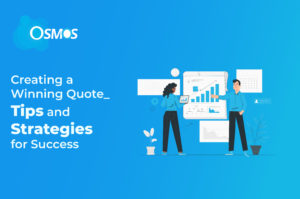The sales quoting process is crucial to business success. Every business designs its own in a specific way, and what works for one might not necessarily work for the other. Granted, this is determined by the nature of the business and the types of customers being targeted.
Smaller businesses tend to have very informal variants in place, but that does not mean a sales cycle is non-existent. Quoting adds structure and formalizes each step contained within. From the first customer interaction to closing the deal, it’s all about making sure things go according to plan.
Here’s how you can build an optimal quoting process with these practices
-
Pay attention to the customer and make a great first impression
Unfortunately, losing track of customer’s needs is an underlying problem affecting various businesses. This form of myopia can be a hurdle to true success. Take your time getting to know the customer – don’t forget, you must tap individual needs in order to create a performing quote.
Personalization is key, and unless you don’t know how your prospect likes it, nothing can be your saving grace. From product details and price to the time your customer would ideally procure them, everything is essential.
-
Automate and streamline
Just like any other department, your sales personnel should be expending their efforts on complex tasks rather than mundane operations that quoting software can easily handle. With Osmos, you can reduce manual exertion and empower your workforce to perform to its potential. Scale sales, save time, recover lost opportunities, manage seamlessly, and close 30% more deals.
Osmos is highly efficient as it supports external applications, easily integrates with ERP’s and CRM’s as well and compiles all quotes from various sources in one place.
-
Present a compelling proposition
This is the most crucial step. The quality of your presentation determines lead conversion and, thus, business growth. So, don’t just go on citing the specifications of your product or service. Instead, link its benefits to the customer’s needs. Naturally, this is connected to the first step. Keep it simple, be transparent, and outline why they should invest their hard-earned money in your business. If they aren’t given good reason, the deal is as good as dead.
Moreover, as a rule of thumb, stick to easy and persuasive language. Make sure not to come off as cold and get it right!
-
Convert and Follow-up
Don’t just assume the job is done here; you need to convert the quote first. Then, follow up. Repeat customers are responsible for a considerable chunk of all revenues, which is why your approach should be long-sighted. After you have closed the deal, remain in touch, and ask for feedback. This is where you have the opportunity to solidify a profitable customer relationship and showcase the value of your business. This does not mean you should pester a client so much they intentionally start ignoring you. Instead, you should show them you care and respect their unique needs and prove your company is worth it.
Positive word of mouth is a crucial factor in driving more business, and one happy customer can be your road to thousands more. With your dedicated sales team using Osmos, the sky is the limit.







